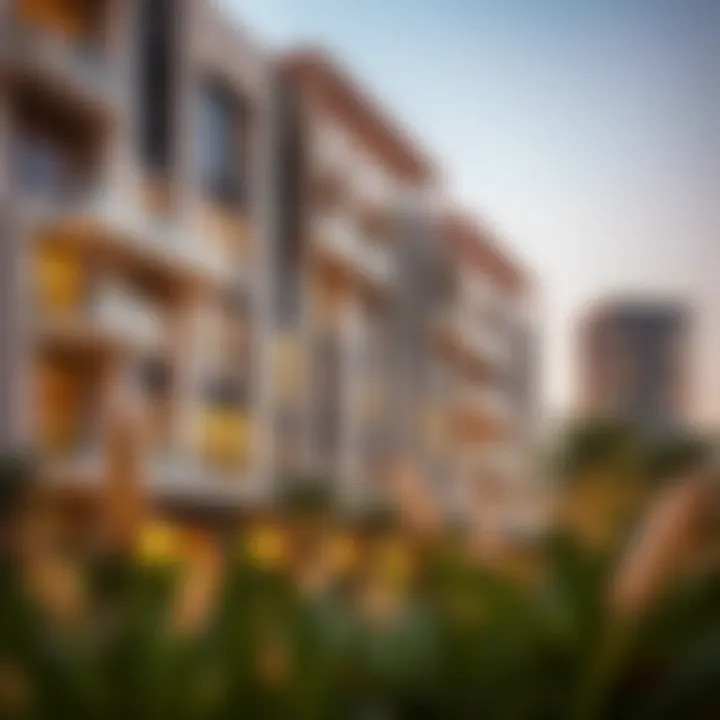Understanding Postal Codes in Dubai International City


Intro
Diving into the postal code system of Dubai International City opens a window into a crucial element of urban life and commerce. Enclosed in this intricate system lies a wealth of information, not just about locations but also about the dynamics of real estate, logistics, and the everyday navigation habits of the residents and businesses.
Dubai International City, a vibrant and diverse locality, is more than just a hub of residential development; it embodies the essence of globalization and multiculturalism. With its various sectors and zones, identifying specific areas via postal codes can be a maze at first glance. However, breaking it down reveals much about the current urban strategies and future endeavors shaping the area.
Understanding the postal code's role goes beyond mere mail delivery. It reflects the socio-economic fabric and the aspirations of those who inhabit this part of Dubai. In this discussion, we'll dissect the significance of postal codes in enhancing logistical efficiency, propelling real estate opportunities, and even simplifying navigation for those frequenting the area.
As we explore, readers will notice the underlying connections between this structured numerical system and the vibrant, ever-evolving nature of Dubai's landscape. Let's embark on this enlightening journey and discover how postal codes serve as the backbone of daily interactions, from residents to businesses and everything in between.
Overview of Dubai International City
When delving into the postal codes used in Dubai International City, it’s vital to first understand the broader scope of this unique locality. Dubai International City is not just a parcel of land; it’s a vibrant community designed to reflect the rich tapestry of cultural diversity. Sitting to the southeast of Dubai’s bustling core, this district is home to multiple nationalities, bringing together flavors and architectural styles from around the globe.
Geographical Context
Dubai International City occupies a prime spot that facilitates easy access to major highways and key points of interest across the emirate. It stretches over an expanse of approximately 800 hectares, strategically located near the Dubai-Al Ain Road, allowing residents and visitors alike to move freely across the city. The area is set to offer a mix of residential, commercial, and recreational spaces, establishing itself as a significant complement to Dubai’s urban landscape.
But what's striking is how this location provides a crossroad of cultures. International City is subdivided into various themed zones, each representing different countries like China, France, India, and many more. This geographical diversity adds layers to the community experience—streets lined with restaurants offering authentic global cuisines, cultural markets, and public spaces where cultural events flourish.
History and Development
The tale of Dubai International City is steeped in the ambitious vision of Dubai’s development strategy. Initiated in the early 2000s, the project was conceptualized to bolster the economy by creating a mixed-use space catering to an international community. Over the years, it has evolved significantly, resulting in multi-storied residential buildings, commercial hubs, and community-centric amenities.
With each phase of development, the focus has been on inclusivity. Properties here range from affordable apartments to upscale housing solutions, making it a magnet for a mix of residents, including young professionals, families, and retirees. The developers understood the pulse of the market, creating a dynamic living environment that supports social interaction and connectivity.
Significance in Dubai
Dubai International City holds a pivotal role in the emirate’s overall urban strategy. Its significance extends beyond mere housing; it embodies the ethos of Dubai as a melting pot of cultures and ambitions. It offers affordable living options, crucial for many expatriates who work in Dubai. Additionally, its commercial zones contribute to the local economy by attracting businesses that capitalize on the diverse consumer base.
The area's contribution to the real estate market cannot be understated. Its unique positioning allows it to maintain attractive property values while ensuring high demand due to its centrality and cultural relevance.
"Dubai International City is a microcosm of the city itself, articulating themes of globalization and multiculturalism."
In essence, understanding Dubai International City isn't merely about geographic lines or the structures that fill them; it’s about grasping how this area plays a crucial role in shaping the identity of modern Dubai. The postal code system here is just one facet of a larger narrative encompassing international cooperation, economic prosperity, and urban innovation.
Understanding Postal Codes
Postal codes are like the unsung heroes of our modern mailing system, quietly bridging the gap between senders and receivers. In the bustling environment of Dubai International City, understanding postal codes isn’t just an academic exercise; it has real-world implications for residents, businesses, and local services. It can greatly influence real estate decisions, enhance logistics networks, and even make navigating urban landscapes more intuitive.
Definition and Purpose
At its core, a postal code is a numerical or alphanumeric identifier assigned to specific regions or addresses. This string of letters and numbers aids in the sorting and delivery of mail, ensuring that items reach their intended destinations without much fuss. In Dubai International City, for instance, the postal code system is fine-tuned to accommodate thousands of residents and commercial entities, facilitating seamless communication across diverse cultures and communities. More than just numbers, these codes symbolize order in a city that thrives on diversity and entrepreneurial spirit.
"A postal code is not merely a tool for the postal service but a vital part of the urban framework that supports real estate development and commerce."
In essence, the purpose of a postal code extends beyond mail delivery—it serves as a fundamental building block for infrastructure, business strategy, and community planning. By accurately defining geographical areas, postal codes help local governments plan services, like waste collection and public transport, aligning with the needs of specific neighborhoods.


Components of Postal Codes
Understanding postal codes involves examining the unique components that comprise them. Typically, a postal code can be broken down into:
- Prefix: This usually indicates a broader area, such as a city or region. For example, in Dubai, the prefix might signify the broader city area of Dubai International City.
- Suffix: This aspect narrows the location down further, often pointing toward a more specific parcel of land or address within that region. In some cases, it can denote a specific building or complex.
- Format: Depending on the country, the structure can vary widely. In Dubai, codes often combine numbers with letters, creating a specific format that is easy to recognize and utilize.
These components work in harmony, forming a streamlined grid that aids not only the postal service but also urban planning and logistical operations within the area. Here, the postal code ideally maps onto the intricate web of streets and neighborhoods, enhancing overall efficiency in delivery services.
Global Postal Code Systems
Postal codes take on different forms across the globe, shaped by the unique needs and infrastructure of each country. For example:
- United States: The ZIP code system breaks down different regions into five-digit codes, with optional four additional digits to pinpoint addresses even more specifically.
- United Kingdom: UK postcodes are highly detailed, often including letters and numbers, which can specify very small areas or even a single building.
Dubai has developed a system that aligns more closely with these global practices, adapting international postal code systems to fit its unique landscape. The postal code in Dubai International City reflects the city's blend of traditional values and modern aspirations, catering to a multicultural population.
In a world becoming increasingly interconnected, understanding these postal code frameworks is critical for businesses and residents alike. As logistics evolve with technology and urbanization, knowing the specific nuances of postal systems can offer a competitive edge. Therefore, postal codes can be a key indicator not just for mail distribution, but also for assessing real estate opportunities, operational logistics, and community accessibility.
Postal Code of Dubai International City
Understanding the postal code system specific to Dubai International City isn't just a matter of numbers; it delves into how these codes affect everyday life in this growing locality. This segment is crucial as it stitches together the fabric of this unique urban environment, revealing how postal codes facilitate the daily activities of residents and the operational dynamics of businesses.
Postal codes in Dubai International City serve several distinct purposes. They help in properly directing mail deliveries, thus reducing potential delays. For those involved in real estate, knowing postal codes can influence property values and help identify desirable or up-and-coming neighborhoods. Investors keeping their eyes peeled on market trends will benefit from recognizing the implications of different postal codes and associated amenities.
Furthermore, postal codes significantly streamline logistical operations in the densely populated area. Having a clear understanding of the postal code breakdown can enhance how businesses manage their shipping and receiving processes. In light of these factors, the discussion of postal codes becomes essential, bridging daily convenience and broader economic factors.
Current Postal Code Overview
When it comes to Dubai International City, the postal code assigned is 45715. This code is not just a random string; it represents a systematic method of organizing the area to ensure efficiency in mail handling and delivery processes. Residents and businesses alike need to use this code correctly to facilitate a smooth postal service experience.
Postal code 45715 encompasses various properties included within the International City, which itself is a sprawling collection of residential and commercial spaces designed with a multicultural influence. The modern architecture in this sector reflects the diverse populace it attracts, and the postal code simplifies communications and services essential for this vibrant community.
The role of this postal code extends beyond merely sorting mail; it also helps in route planning for delivery services. By incorporating such postal codes into their systems, logistics companies can better optimize their delivery schedules, which contributes to timely service and satisfied customers. Moreover, many e-commerce businesses categorize their services based on postal codes, affecting shipping costs and delivery timelines.
Area-Specific Postal Codes
Given the vastness of Dubai International City and the strategic planning behind its design, area-specific postal codes can further dissect this area into smaller, recognizable segments. While the overarching postal code of 45715 applies to the entire district, subdivisions within might use different codes for more precise identification.
For example, zones B, C, and D in Dubai International City might have unique identifiers attached to their residential and commercial postings. This allows for more detailed geographical plotting that can inform residents about nearby facilities, amenities, and community services.
- Key Benefits of Area-Specific Postal Codes:
- Enhanced Delivery Accuracy: Postal services can pinpoint exact locations quickly.
- Informed Decision-Making for Buyers: Potential homebuyers can easily understand the characteristics of specific areas, including school proximity and community features.
- Marketing Strategies for Businesses: Companies can target specific demographics based on the postal distribution of their clientele.
Impact of Postal Codes on Real Estate
In the world of real estate, postal codes often serve as an unsung hero, quietly shaping perceptions and driving market dynamics. Dubai International City, a vibrant and multicultural hub, showcases how postal codes can significantly impact buyer behavior and rental trends. Understanding this influence is crucial not just for investors or developers but for anyone involved in real estate in this area.
Buyer Perceptions


The significance of postal codes in shaping buyer perceptions cannot be overstated. When potential homeowners or investors consider purchasing property, they do not just look at the property itself; they also pay keen attention to its postal code. In the case of Dubai International City, certain postal codes may resonate more positively due to their association with amenities, connectivity, and even local demographics.
For instance, a postal code that reflects proximity to vibrant community centers or essential services can enhance its desirability. Buyers often think, "If it's in a postal code that’s buzzing with activity, it must be a good place to live!" This perception can lead to a willingness to pay a premium for properties in areas deemed more accessible or attractive due to their postal classifications.
- Proximity to Amenities: Residents often prefer locations near essential facilities like schools, hospitals, and parks, all influenced by postal code positioning.
- Community Reputation: Certain postal codes in Dubai International City might carry a reputation that enhances their marketability among buyers.
A postal code can also influence resale value. When a property is located in a well-regarded area with a solid postal code, it can help spark a bidding war among buyers. This leads to homes appreciating in value, an appealing factor for sellers.
Rental Market Dynamics
The interplay between postal codes and rental market dynamics in Dubai International City is equally compelling. Areas distinguished by specific postal codes tend to attract different tenant profiles. For example, a zip code associated with residential comforts might attract families, while those in proximity to business hubs may appeal more to young professionals or expatriates.
Tenants often search for convenience, safety, and vibrancy—all of which can be indicated by postal codes. As such, rental prices can fluctuate depending on these factors. In a fast-paced market like Dubai, an attractive postal code might allow landlords to command higher rents, making it critical for landlords to be aware of how their property's postal code is viewed in the market.
- Price Variability: Rentals in prime postal code regions often exceed those in less popular areas by significant margins.
- Demand for Proximity: As industries shift and businesses grow, demand in particular postal code areas can see sharp spikes, leading landlords to adjust rental prices accordingly.
Ultimately, navigating the real estate market in Dubai International City requires a fine-tuned awareness of the effect postal codes have on both buyers and renters. It’s an often-overlooked aspect of the broader real estate conversation but one that undeniably shapes market behavior and investment potential. Addressing these dynamics can ultimately lead to smarter decisions and more profitable outcomes for all stakeholders involved in this flourishing urban enclave.
Role of Postal Codes in Logistics
When examining the impact of postal codes, one cannot overlook their vital role in logistics. The structure of postal codes serves multiple purposes within the realm of logistics, encompassing everything from improving delivery efficiency to influencing strategic business decisions. For an area like Dubai International City, where diverse businesses thrive and the population constantly fluctuates, understanding this role becomes even more pertinent.
Efficiency in Delivery Services
Postal codes provide a grid-like framework that helps delivery services navigate through the complexities of urban landscapes. By segmenting regions into identifiable areas, postal codes allow for much quicker sorting and routing of parcels. For instance, couriers can prioritize routes based on the density of addresses within certain codes, ensuring timely deliveries.
- Route Optimization: With precise postal codes, delivery services can employ algorithms that map out the most efficient routes, reducing overall travel time.
- Team Allocation: Companies can allocate their workforce more effectively, deploying more delivery staff to high-demand areas, indicated by postal cluster patterns.
- Tracking and Reporting: Modern logistical platforms utilize postal codes to provide customers with real-time updates on their deliveries, enhancing transparency.
In a place like Dubai International City, where the layout is diverse and often busy, the usefulness of postal codes extends beyond mere address identification. They streamline the coordination required in a bustling city, making it possible for businesses to operate smoothly and manage the flow of goods effectively.
"Navigating the intricate web of logistics would be a Herculean task without the simplicity offered by postal codes."
Challenges Faced by Businesses
While postal codes offer a structured method for logistics, they are not without their challenges. Many businesses encounter difficulties that arise from relying solely on this system, particularly in a multicultural hub like Dubai International City.
- Misinterpretation of Codes: Each postal code can encompass multiple residential blocks or commercial spaces, leading to confusion during delivery.
- Half-Completed Data: In some cases, inadequate updates to postal code data can result in delivery routes that no longer reflect the current state of the area. This could lead to delays or missed deliveries, directly impacting customer satisfaction.
- Varying Regulations: Different businesses operating within a single postal code might be governed by distinct regulations, complicating logistics further.
In summary, while postal codes enhance logistical efficiency for delivery services in Dubai International City, they also present challenges. Businesses must navigate misinterpretations, potential data issues, and regulatory discrepancies to ensure smooth operations and maintain high service standards.
Navigational Aspects of Postal Codes
Navigational aspects of postal codes are crucial for effective movement around a vibrant location like Dubai International City. These postal codes do not merely serve as numeric identifiers; they function as navigational aids that simplify the often-complicated journey through a bustling urban landscape. Understanding their role can greatly enhance one’s ability to find destinations quickly and efficiently, greatly benefiting residents, tourists, and businesses alike.
Using Postal Codes for Navigation
Using postal codes as a navigation tool brings several advantages. For instance, individuals relying on delivery services can ensure their items arrive at the correct location without hiccups. Furthermore, when using GPS systems, entering a postal code can save time and hassle, especially in a city where many streets and buildings may appear similar or are less clearly labeled.


Here are some notable benefits of using postal codes for navigation:
- Precision: Postal codes pinpoint locations with high accuracy.
- Simplicity: Entering a postal code is often quicker than typing out an entire address.
- Efficiency: Drivers can plan their routes based on postal code clusters, making trips more efficient.
For example, if a delivery driver needs to get to Al Warsan in Dubai International City, simply using the postal code improves the chances of getting there without detours or delays. It acts like a shortcut to where people want to be.
Integration with Mapping Technology
The integration of postal codes with mapping technology marks a significant step forward in enhancing navigational efficiency. Many modern mapping services like Google Maps incorporate postal codes into their systems, allowing users to get tailored directions effectively. This offers a twofold advantage: not only do users find their destinations faster, but businesses also benefit from increased customer satisfaction when deliveries or visits are made correctly on the first try.
Consider these key points regarding this tech integration:
- Real-Time Updates: Mapping services constantly update their algorithms, ensuring that when postal codes are entered, the user gets the most current route options.
- Route Optimization: Certain applications can analyze traffic patterns and suggest the quickest paths based on postal codes and current conditions.
- Enhanced User Experience: Users can expect a smoother experience as they can visualize their journey through high-definition maps that incorporate postal code data.
The fusion of postal codes with digital mapping technology streamlines not just personal travel, but also the logistics of businesses operating within Dubai International City. This synergy exemplifies how urban life is evolving alongside technological advancements.
In short, the navigational aspects of postal codes transcend their traditional role, transforming them into dynamic tools that facilitate effective movement within Dubai International City. As mapping technology continues to advance, the interplay between postal codes and navigation will only deepen, crafting an urban experience that is both intuitive and user-friendly.
Future Developments in Postal Services
As Dubai International City continues to evolve, the postal services within it stand on the cusp of transformation. An examination of future developments sheds light on both how the infrastructure anticipates growing demands and how innovations are set to redefine everyday interactions with postal systems. For residents, businesses, and visitors, understanding these changes can lead to insights into more efficient communication and service delivery.
Technological Innovations
Technology increasingly plays a pivotal role in enhancing postal services. In Dubai International City, advancements are being integrated in various forms:
- Automated Sorting Systems: These systems improve the speed at which mail is processed, reducing the time between sorting and delivery.
- Smart Mailboxes: Enabling users to track deliveries in real-time, these mailboxes facilitate not just convenience, but also security.
- Drones for Delivery: The potential for drone technology to transform last-mile delivery cannot be overstated. Imagine packages arriving at your doorstep, just like that, without the hassle of traffic.
These innovations not only streamline operations but also cater to the contemporary consumer's expectations for immediacy.
Predicted Changes in Dubai
Looking ahead, it's clear that the dynamics of postal services in Dubai will see significant shifts, all bent toward enhancing efficiency and user experience:
- Integrated Services: Future models predict a merging of postal and parcel services with other city services. This can mean everything from utility bill payments to e-commerce deliveries centralized within one interface.
- Sustainability Initiatives: With global emphasis on eco-friendliness, the postal services may adopt electric vehicles to cut down carbon footprints, ensuring that services also align with environmental stewardship.
- Personalized User Experiences: As data analytics and customer profiling evolve, the services may become more tailored to individual users. Just think – mail and services could be optimized based on your past preferences.
The changes in postal services are essential not just for enhancing logistics but are also a reflection of Dubai's broader ambitions toward becoming a leading tech hub.
As these changes are anticipated, both residents and businesses in Dubai International City should stay informed and adaptable to harness the opportunities arising from these advances.
End
The importance of postal codes in Dubai International City extends well beyond just sorting mail. It is the backbone of not only logistics but also offers crucial insights into real estate dynamics, community planning, and even consumer behaviors. Postal codes serve to categorize and define the area, making it easier for residents and visitors alike to navigate this growing urban structure. Businesses leverage this information to streamline their operations, while investors may view certain postal code areas as more desirable based on their economic indicators and demographic information.
Summary of Key Insights
- Facilitation of Services: Postal codes simplify navigation for delivery services and residents, enhancing overall efficiency.
- Real Estate Trends: Understanding area-specific postal codes can aid potential buyers and investors in making informed decisions based on market trends and demand. This knowledge can help discern which areas are prime for future appreciation, offering investors a strategic edge.
- Logistical Considerations: Businesses operating in Dubai International City can optimize their delivery operations by understanding the implications of postal codes on routes and service areas, resulting in enhanced customer satisfaction.
- Civic Understanding: Knowledge about postal codes can lead to a better understanding of community demographics, which can enhance civic engagement by informing various stakeholders about the makeup of the neighborhood.
"Postal codes are more than just a string of numbers; they are a language of locations that speak to our connectivity and community structure."
Final Thoughts on the Importance of Postal Codes
Postal codes fundamentally shape how cities function, influencing everything from service delivery to investment potential in areas like Dubai International City. For real estate agents and investors, recognizing the nuances of postal codes can be the difference between making a savvy investment or falling behind the curve on emerging trends. Additionally, they play a significant role in logistics, as a well-defined postal code allows for improved routing and less congestion in delivery services.
In a city that prides itself on being global and expansive, understanding the postal code system is not just beneficial; it’s essential. As Dubai continues to grow and evolve, so too will the landscape of its postal code system, making ongoing education about its implications vital for all stakeholders involved.







